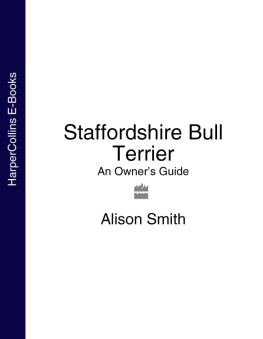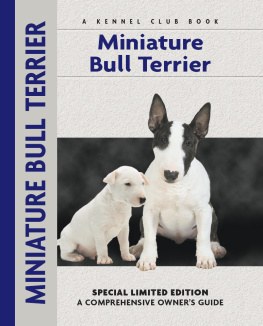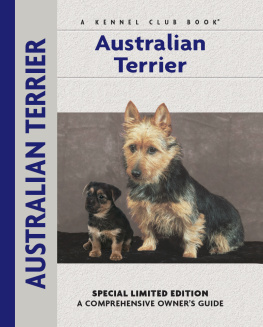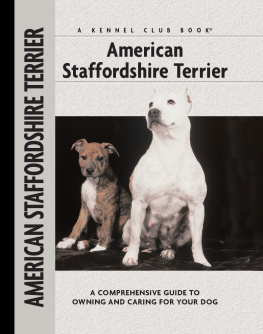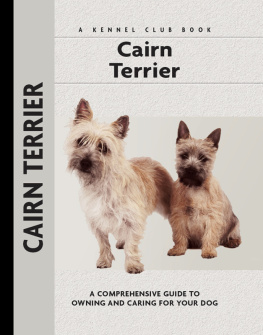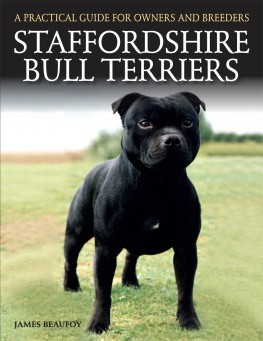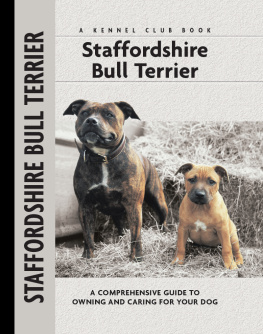
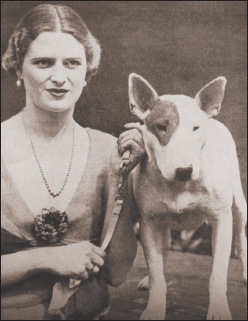
A Bull Terrier was the pet of the famed actress Miss Jean Melville. This photo was taken circa 1932.
Why the Bull Terrier was developed back in England in the 1800s has very little to do with todays Bull Terrier. The Bull Terrier is based on bull-and-terrier dogs, which were bred for baiting and dog fighting, sports that were eventually outlawed in Great Britain in the 19th century. These early dogs were bred for function, not form, and were completely devoted to their owners.
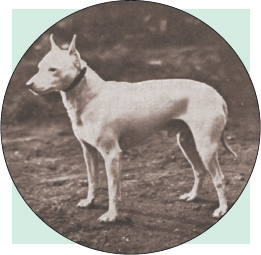
The extinct English White Terrier, an acknowledged forerunner of todays Bull Terrier. Photograph by C. Reid, circa 1890.
The origin of the Bull Terrier breed can be traced directly to a man named James Hinks, of Birmingham, England, who after years of experimentation introduced the breed in the 1850s. The Bull Terrier is based loosely on the now-extinct English White Terrier. Hinks spent years crossbreeding with bull-and-terrier dogs, attempting to build a bulldog that was not only better fitted to the pits but also better looking. By breeding out some traits seen in many early pit-fighting dogs, such as the roach back, overly angulated legs and undershot jaw, and injecting some size and strength (possibly from crossbreeding with the Spanish Pointer), the result was a handsome, proud gladiator, fit to walk next to a gentleman. The Bull Terrier retained a positive attribute of its bull-and-terrier predecessorsunmatched loyalty to his owner.
If there was any question that the Bull Terrier was too pretty for the dog pits, the myth was quickly dispelled. The feisty, fight-to-the-death spirit of the Bull Terrier made him a relentless fighter in the pits, often beating dogs almost twice his size. Legend has it that Hinks himself once matched his 40-lb bitch Puss of Brum against the never-wary Mr. Tuppers 60-lb bull-and-terrier cross. Not only did Puss emerge victorious from the bloody bout, but Hinks whisked her away to the Holborn dog show later in the daywhere she won a red ribbon!
The Bull Terrier was also quite a rat fighter, another unusual blood sport that was quite popular in England. Bull Terriers held the unofficial records for most rats killed in minutes, hours and other time frames.

Noted English breeder of the 1930s, Mrs. Adlam, with her Bull Terriers, Ch. Brendon Gold Standard, Ch. Brendon Beryl and Boomerang.
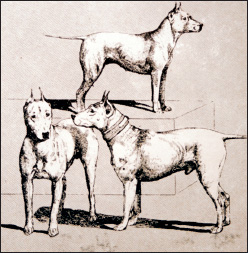
Bull Terriers depicted in an engraving from the end of the 19th century. Note the dramatic differences in the head style and length of leg, compared to our modern Bull Terriers.
Though Hinks was quite proud of his creations success in the dog- and rat-fighting pits, he was more interested in winning at the dog shows, which were beginning to rival dog fighting in popularity in Britain. In the 1860s, dog fanciers and show judges became partial to the all-white Bull Terriers; as a result, Hinks set forth to create a more consistently all-white breed. By culling piebald and brindle pups, breeding white dogs to white bitches and possibly introducing Dalmatian blood, Hinks was successful in creating all-white Bull Terriers. To this day, however, both types remain, classified as two varieties of the same breed, White and Colored Bull Terriers in the US and as one breed in the UK.

From 1907, this Bull Terrier bitch, known as Millstone Venus, exhibits the changing fashion in breed type. She is much slighter and higher on leg, with a longer, nearly elegant neck.
Throughout England, it became fashionable for gentlemen to sport Bull Terriers at their sides. Fearless, strong, loyal, well-mannered and friendly, the Bull Terrier was a stylish addition to the gentle-mans retinue and became known as the White Cavalier. The Bull Terriers acceptance in upper-class society and success in the dog-show circuit were blessings, as the breed became known more as a peoples dog than a fighting dog, eventually resulting in the friendly and typically peaceful Bull Terrier we know today.
WHITE CAVALIERS INVADE AMERICA
BY DAVID HARRIS
With the burgeoning popularity in Britain of James Hinkss new all-white Bull Terriers during the 1860s, it was inevitable that these so-called White Cavaliers would soon appear in America. The first such importsCorvina and Puss IIIare believed to have been brought back in 1869 by James Cruikshank of Pittsburgh. By 1877, when the Westminster Kennel Club staged its first Bench Show of Dogs, 11 Bull Terriers were entered with names typical of the day like Nell, Rose, Jim, Billy and Lillie. Most were entered for sale, a common practice at early shows, with prices ranging from $50 to $500. The following year a show in Boston attracted no less than 23 Bull Terriers. James Watson noted that the first White Cavaliers of class shown in America were Ch. Tarquinthen the top winner in Englandand his son Superbus, which were sent over in 1880 by Sir William Verner for exhibition in New York. The American Kennel Club (AKC) was established in Philadelphia in 1884, the first Bullterrier (AKC used one word rather than two until 1937) being entered in the stud book a year later. The entry reads Nellie II, #3304. No sire or dam given Quite remarkably, however, Nellie II was one of the old-style brindles not a White Cavalier.
The most prominent figure in the breed at that time was Frank Dole of Connecticut, who imported, bred and sold numerous Bull Terriers. Many of his imports came from James Hinkss son Fred. Doles biggest winner was Ch. Starlight, a daughter of the imports Ch. Grand Duke and the great Ch. Maggie May. In 1899, at nearly 12 years old and with few front teeth left, the incredible Starlight was still able to win at a New York show. Two other stalwarts, William Faversham, the celebrated actor, and T.S. Bellin, did much to support and popularize the breed. Both were Englishmen who emigrated during the 1880s. The Bull Terrier Club of America (BTCA) was established initially, under the presidency of Frank Dole, in 1895. This was the year in which ear cropping was banned in Britain, a major blow to cropped breeds like Bull Terriers. And such was the belligerency of the new club on this matter that it was expelled from AKC membership for conduct prejudicial to the welfare of the American Kennel Club. But by 1897 the BTCA was again a member club. In those days most members of the clubs committee lived in New York, Connecticut and Massachusetts.

BTCA
The Bull Terrier Club of America is the AKC parent club for the breed. The clubs main purpose is to promote the Bull Terrier and protect the breeds best interests through club activities. The club provides owners, breeders and fanciers with a network of contacts in the US and also reaches out to Bull Terrier people all over the world. The club offers continuing education to those in the breed, as well as informing newcomers to the breed and helping them decide if the Bully is the breed for them. Their breeder referral service ensures new owners that they will be matched up with a reputable, ethical, knowledgeable breeder from which to obtain a puppy. The club has many regional affiliates and sanctions shows throughout the country. The major Bull Terrier event of the year is the BTCAs annual national specialty show. In addition, the club offers special awards and recognition to those dogs whove achieved success in the show ring and performance events. The BTCAs health committee supports research, studies and dissemination of information about health problems with the goal of eventually eliminating these problems from the Bull Terrier through careful breeding. The club also supports breed rescue, in which dedicated volunteers across the country take in Bullies from unfortunate situations, such as neglectful homes or animal shelters, caring for the dogs until they are placed in good homes. Visit the BTCA online at www.btca.com to acquaint yourself with all that the club does for the breed.
Next page

